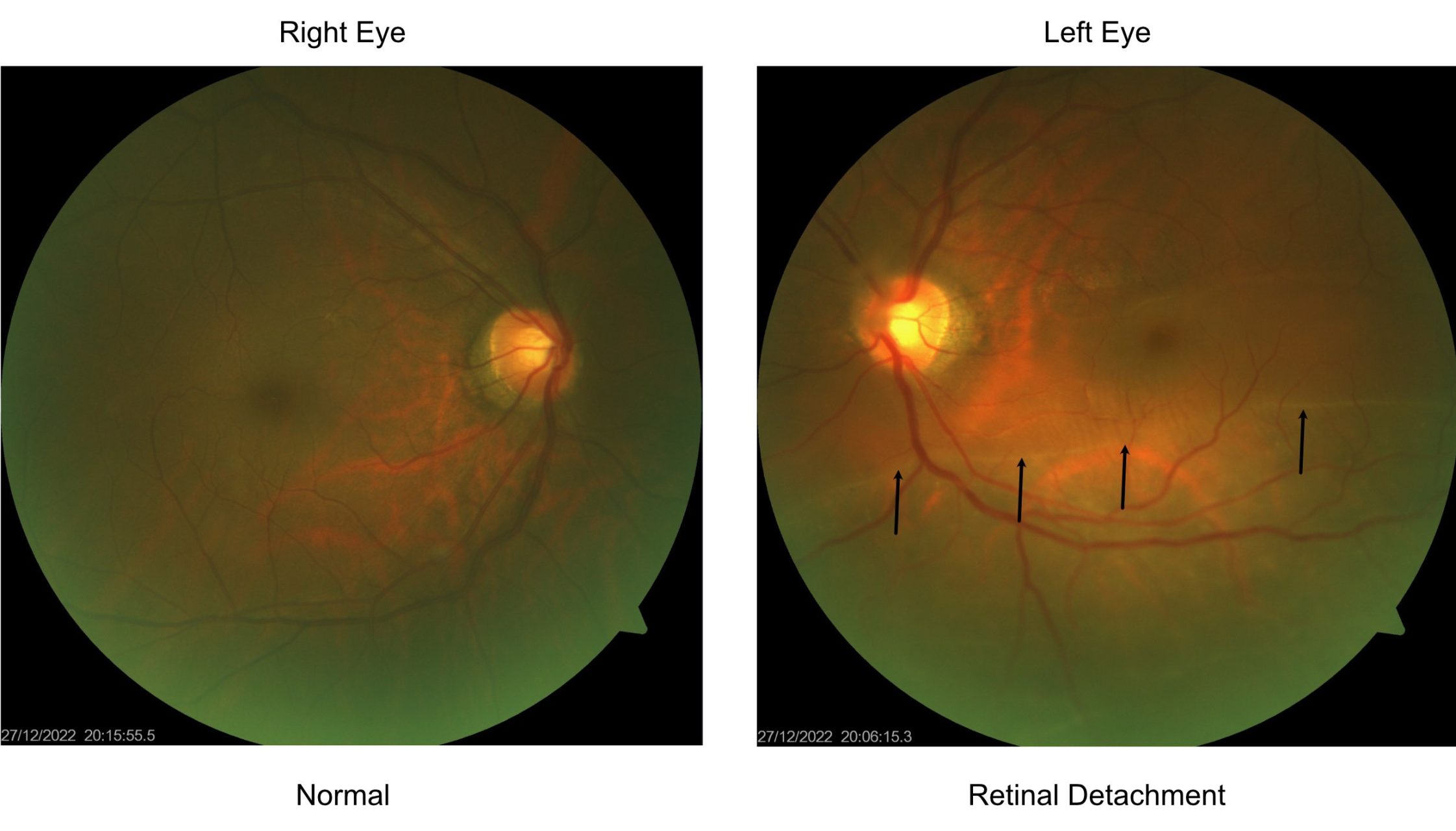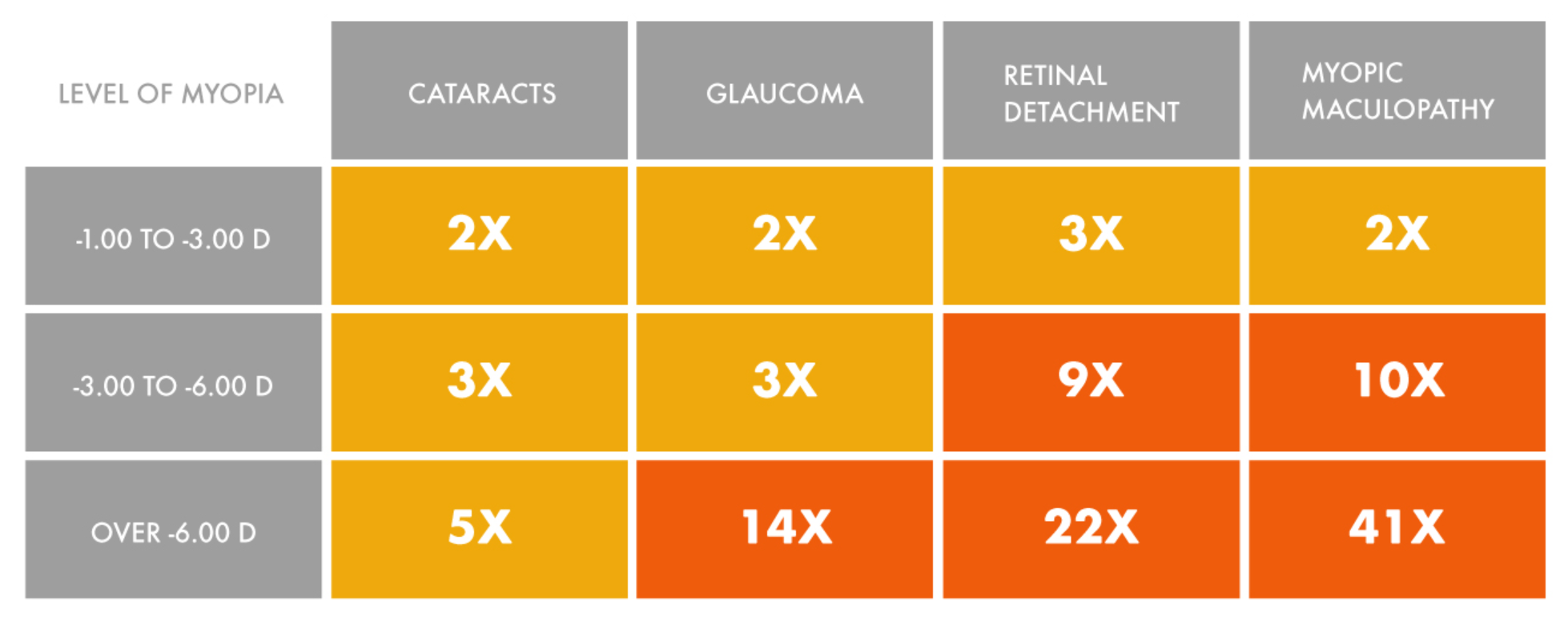Retinal Detachment in Singapore
Retinal detachement is an emergency eye condition whereby the retina (thin layer at the back part of the eyes) separates from the outer part of the eyes. The longer retinal detachment is left untreated, the higher the risk of permanent vision loss in the affected eye. Hence, it is important to treat retinal detachment early.
Symptoms
- Sudden increase in numbers and size of floaters
- Flashes of lights
- ‘Black / Gray curtains covering your vision / side vision


Floaters are small specks floating around your vision. It is normal to see floaters occasionally. However, if you see a sudden increase in size and numbers of floaters, especially with flashes of light and dark curtains, then it could be due to retinal detachment.

Risks Factors
- Myopia (The higher the myopia, the higher the risks of retinal detachment)
- Has history of retinal detachment in one eye
- Previous eye surgery
- Severe eye injury
Treatment
The longer the retina is left detached, the higher the risk of permanent vision loss. Once the retina is detached, you can loss your vision within a few hours or a few days. Hence, it is important to seek treatment as soon as possible to prevent permanent vision loss. Visit the A&E immediately if you experience any symptom of retinal detachment as mentioned above or have been suspected to have retinal detachment by an optometrist.
Case of Retinal Detachment we saw @ Evershine Optical
Just a few months ago, a 53 years old female came in for a comprehensive eye exam. 2 months ago, she went to her regular optical chain store to make glasses and 2 weeks later she went back again to make another pair. To her horror, her prescription on her left eye had dropped by -200 degrees. Her optician only advised her to update her prescription. She was worried about it, hence she came to us for a comprehensive eye exam.
We asked her more questions about any other complains and found that she experience:
- Left eye: Blurry vision, feel that got something in front of it, see floaters (less than 10) and a black area at the top part of her vision when she look up
- Words does not look straight
With this history taking, we suspected that there was retinal detachment in her left eye. As mentioned above, the symptoms of this condition are floaters, flashes of light and black curtains. She had 2 symptoms, floaters and black curtain. We then did more checks to confirm the diagnosis.
After checking her eye power, we found that her myopia had indeed dropped by -200 on her left eye, which was a huge change in a short amount of time. Despite correcting her power, her left eye’s vision was still poor and could not be further improved until 6/6 with glasses.
From her prescription (about -700), it indicated that she was a high myope which increased the risk of her getting retinal detachment.
We later assessed her eye health using a slit lamp and could not find anything significant, eg, cataract.
We decided to use a ZEISS Visucam to do a fundus photography which was to take pictures of her retina (back part of her eyes). The images below are pictures of her eyes.

The whitish line pointed by black arrows on the left eye shows the retinal detachment.
After reviewing the pictures with our senior optometrist, we could almost confirm that there was a retinal detachment on her left eye.
We explained to her that her prescription change was due to the retinal detachment and this is an emergency condition which will affect her vision, causing permanent vision loss. We quickly refer her to an eye specialist to seek for treatment. She later confirmed her diagnosis with the eye doctor and had treatment for it.
How to lower your risk of Retinal Detachment
Retinal detachment cannot be prevented, especially for myopic adults.
However, there are ways to lower the risk of getting it especially for high myopic patients:
- Avoid activities such as bungee jumping, rollercoasters, skydiving
- Avoid eye injuries
- Have regular comprehensive eye examinations
Regular eye examinations are important as they are able to pick up the signs of retinal detachment before you even start to experience symptoms.
On the other hand, for myopic children, you can lower their risk of retinal detachment in the future by controlling their myopia progression when they are young. By starting myopia control early for your child, allows their resultant myopia in the future will be lower than without myopia control, which will lower their risk of retinal detachment and other eye conditions.
The table below shows the risks of your child developing eye complications as their myopia gets higher as compared to children without myopia.

Comprehensive Eye Exam @ Evershine Optical (Toa Payoh)
It is important to have regular eye examination, not only to check power, but also the health of your eyes. If you present floaters, optometrists @ Evershine Optical will ask you questions such as when did you start noticing the floaters, did the size and numbers of floaters increase and more. A comprehensive eye examination will be conducted to find out the cause of your floaters, this include assessing the:
- Eye power
- Health of the front and back part of your eyes
- Eye pressure
- Fundus Photography with ZEISS Visucam 500
- Axial Length Measurement with ZEISS IOLMaster 500 (measure the length of your eyes)
Book an appointment with us or WhatsApp us at +6588461234 for a comprehensive eye exam to check your floaters.
References
- Floaters & Spots. American Optometric Association.
- Retinal detachment. American Optometric Association.
- Syed Z, Stewart M. (2016). Age-dependent vitreous separation from the macula in a clinic population. Clin Ophthalmol. 10:1237-43.


